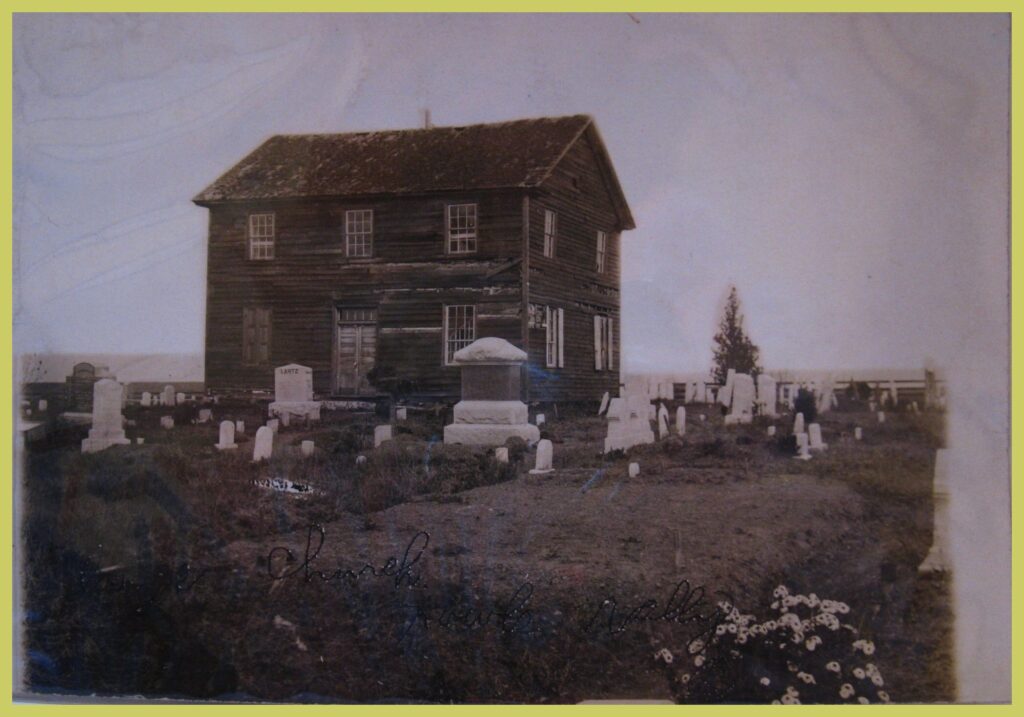
An undated photograph of Long’s Church and Cemetery, south of Halifax, Dauphin County, Pennsylvania. The cemetery is till there (along Route 147), but the church building is long gone, being razed in 1920. The building served as a union church for Lutheran and Reformed congregations in Powell’s Valley.
The following brief description of the history of the church and cemetery appeared in the Harrisburg Telegraph, May 16, 1896. It was a reprint of a sketch from Egle’s Notes and Queries, Volume XIX.
LONG’S CHURCH, POWELL’S VALLEY, DAUPHIN COUNTY
On a beautiful day of this month the writer landed in the ancient town of Halifax, which is located, where during frontier times of our provincial days, stood Fort Halifax, and after a walk of more than a half hour, along the public road leading to Matamoras, we found our objective point – Long’s Church. This church is one of the few not recorded in the histories of Dauphin County. A century ago and less, there settled here on a farm, by purchase, Henry Long, form the vicinity of Jonestown, Lebanon (then Dauphin County). Here he continued to reside and followed farming and practiced his profession of medicine in this rude and unskillsed way – his pharmacy consisting of the roots and herbs from the fields and mountains.
The location is the most charming in Powell’s Valley. The church and graveyard is located on a gentle elevation, where you have two miles distant to the southeast the Peters Mountain, while to the northwest is the silent, silvery waters of the Susquehanna, winding its currents around Berry’s Mountain, and to the west the rolling lands of Perry County, which end abruptly on the edges of the river interspersed with notches and ravines. One of them, “Girty’s Notch,” known as such since the days of the Revolution, and named after Simon Girty, known in history as “Girty, the White Savage,” is in view. Girty’s father, of the same name, was as early as 1740 licensed as a trader on the frontiers of the provinces located on Shearman Creek in the vicinity, where Duncannon is now located. Some time afterward they were dispossessed by the sheriff. The boys, one of which was Simon, afterwards was adopted by the Seneca Indians, and he became a valuable adjunct for the red savages.
To the northeast you have a charming view of Powell’s Valley, now in full bloom on every fruit and shrub tree, with sturdy yeoman dotted here and there planting the corn.
Long’s Church was erected about seventy-five years ago [circa 1821] and is a two-story log weather-boarded structure, with but one floor and surrounded on three sides with a very wide gallery. The appearance of the the building now [1896] shows great neglect, on the part of some one, surely not by the Lutheran denomination, by whom it was erected. The small graveyard, as originally laid out, has outgrown its capacity, and by the takin in of additional ground it is called a cemetery, and the good condition the ground is kept in puts to shame the dilapidated appearance of the church.
Here are buried some of the early settlers of Powell’s Valley, who left the Scotch-Irish and German settlements across Peters’ Mountain prior to this century….
The remainder of the article was an alphabetical list of burials in the cemetery.
____________________________________________________
For further information contact the Halifax Area Historical Society.
News article from Newspapers.com.
Corrections and additional information should be added as comments to this post.